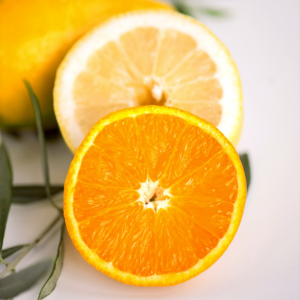Know Your A-B-Cs: Antioxidant Vitamins for Youthful Skin
Everyone knows that vitamins are good for you. But when it comes to smooth, healthy and beautiful skin, some rise above other skincare ingredients. These vitamins are antioxidants, and they are a must-have in your regular regimen. The Big Five for beauty are — conveniently — vitamins A through E.
Before you can understand how antioxidants like A to E benefit your skin, you first need to be familiar with free radicals.
Defeat the Free Radicals
Not a ‘70s political protest group, free radicals are unstable molecules. Short an electron, they stabilize by stealing electrons from other molecules. Too many free radicals causes what’s called oxidative stress. It damages your skin’s lipids, proteins and DNA, and radically changes skin function, deteriorates cellular structures and causes inflammation. Not pretty. Over time, oxidative stress is a major contributor to premature aging.
What causes free radicals to surge are a familiar skin-health blacklist, including UV radiation (sun), unhealthy diet, stress, smoking, air pollutants, lack of sleep, and too much meat or alcohol. As you age, free radical levels increase, while your skin’s defenses against them decrease.
Save Face with Antioxidants
Keeping your face its freshest requires avoiding aggressors and providing your skin with abundant antioxidants. Antioxidants neutralize free radicals by giving them the electrons they’re missing. When antioxidants outnumber free radicals in the right proportion, they protect your skin from oxidative damage.
The best ways to get antioxidants are through high-quality topicals and a diet rich in fresh fruit, vegetables, nuts, seeds, herbs and legumes. Supplements may be tempting, but beware. They make it too easy to exceed a healthy dose — paradoxically increasing oxidation!
When you’re determined to defeat free radicals and up your skincare game, the best first step is to consult a board-certified dermatologist or licensed aesthetician. They can get you started right with vitamins A through E.
Antioxidant #1 – Vitamin A
Vitamin A (aka retinoids) is one of the most widely used and celebrated antioxidant vitamins for skin. It comes in two main topical formats: retinol and tretinoin. Retinol stars in hundreds of OTC products, while tretinoin (Retin-A) is more powerful so requires a prescription.
Working in essentially the same way, both have brought users remarkable results. Retinol and tretinoin are composed of molecules so tiny that they’re able to penetrate down into the skin. There, they tell your skin to make fresh new cells, collagen and blood vessels. Retinoids have proven in many dozens of clinical trials that they smooth out fine lines, prevent new wrinkles, plump up skin, lighten hyperpigmentation, and reduce acne and related scarring.
Pairs Well with…
Exfoliation. Clearing away dead cells allows retinol and tretinoin to better penetrate your skin. Depending on exfoliant strength, you can treat your skin at home as often as five days a week. It’s safer to use a chemical, rather than physical, exfoliant to avoid tugging or scratching skin.
Soothing, conditioning and healing ingredients. Some dryness and irritation is normal with retinoids, particularly in the beginning. However, you can find effective retinol products for sensitive skin, with ingredients like chamomile, aloe vera, hyaluronic acid or other antioxidants.
Sunscreen. By stimulating production of new skin cells, retinoids make skin fresher looking but also more vulnerable to sun damage. Retinol and tretinoin make it all the more important to wear sun protection outdoors during the day, always. Choose a full-spectrum sunscreen that offers at least 30 SPF. You need to like the way it looks and feels on the skin, so you’ll be more likely to wear it.
Where to Find Retinol and Tretinoin
You get beta carotene (provitamin A) by eating fresh orange produce, like carrots, sweet potatoes, cantaloupe and pumpkin. Your body converts beta carotene to retinol, which helps defend skin from oxidative stress.
However, of all the antioxidant vitamins, vitamin A may be the most effective as a topical. This explains the huge number of OTC retinol skincare products. The best way to start with retinoids is with a retinol treatment like California Skin Institute’s Enriched Retinol Eye Repair or Smoothing Retinol Body Lotion. They deliver the benefits of retinol, while keeping dryness and irritation at bay using ceramides and hyaluronic acid. As your tolerance builds, work your way up to a clinical-grade retinol product.
Next, consider gradually introducing tretinoin. See a board-certified dermatologist to give you a Retin-A prescription, as well as customized guidance on your ideal concentration and frequency of use.
Antioxidant #2 – Vitamin B
“Vitamin B” is actually a group of eight different vitamins. The two most widely proven to help skin look amazing are B-3 and B-5.
Vitamin B-3: Niacinamide
Niacinamide has been gaining a reputation as a kinder, gentler vitamin A or C. Like these better-known antioxidant vitamins, B-3 improves skin texture, tone and volume. It lightens dark spots, reduces pore size, smooths fine lines, softens roughness from sun damage, and increases production of springy new collagen and elastin.
What’s specific to B-3 is its effectiveness at bolstering the skin’s natural protective barrier. A stronger barrier keeps your skin better hydrated by blocking transepidermal water loss (TEWL), and it ups your skin’s guard against free radicals and everyday irritants. Niacinamide can also put a damper on inflammation.
Pairs Well with…
Similar ingredients and dry skin. Niacinamide’s rejuvenation power is amplified when it has the right co-ingredients. Results are particularly good alongside ingredients that, like B-3, fight free radicals, hydrate skin and strengthen the dermal barrier. Niacinamide is a great match for parched, sensitive skin.
Vitamin A or C. Topical niacinamide is often recommended to counter dryness or irritation caused by retinol, tretinoin or vitamin C.
Where to Find Niacinamide (Vitamin B-3)
A wide variety of foods contain niacinamide, so you don’t need to go out of your way to get enough. Excellent sources of dietary B-3 are legumes, brown rice, seeds, nuts, eggs and bananas.
Topical niacinamide shows up frequently in anti-aging creams and serums for thirsty or reactive skin. For instance, California Skin Institute’s Intensive Moisture Cream and Lipid Barrier Cream combine niacinamide with quenching hyaluronic acid, fortifying ceramides, firming peptides, and other antioxidants including resveratrol, green tea polyphenols, vitamin E and caffeine.
Vitamin B-5: Panthenol
Panthenol is used in skincare products to hydrate, smooth and soothe. It’s both a humectant and an emollient, so it attracts and binds water to the skin at the same time as it softens and seals. Panthenol is used widely to calm inflammation and treat surface damage to the skin.
Pairs Well with…
Similar ingredients. You can amplify panthenol’s rejuvenating benefits with skincare products containing other humectants, antioxidants and emollients. For instance, hyaluronic acid and glycerin further panthenol’s ability to infuse skin with moisture, while ceramides help B-5 trap it in.
Where to Find Panthenol (Vitamin B-5)
It would be difficult to avoid getting enough dietary vitamin B-5, since basically all natural foods contain it. Rich sources are mushrooms, avocado, broccoli, whole oats, potatoes, dairy and eggs.
Panthenol is also common in skincare products — from facial cleanser to hand cream.
Antioxidant #3 – Vitamin C
Vitamin C is a powerful weapon — and shield — against the signs of aging and sun damaged skin. It fades hyperpigmentation, inhibits melanin overproduction, and encourages turnover and regeneration of skin and collagen cells. Users of vitamin C skincare products swear by them for a brighter complexion, more even tone, and softer and smoother texture. A number of clinical trials have shown vitamin C to reduce scarring.
Pairs Well with…
Vitamin E. Vitamin C is highly unstable. If you want to avoid chemical preservatives, look for vitamin C skincare with vitamin E. Vitamin E helps vitamin C retain potency, at the same time as it contributes to skin rejuvenation.
Ferulic acid. If you’re primarily concerned about sun damage, ferulic acid may help provide protection. It’s most effective when blended with vitamin C and vitamin E.
Sunscreen. You can’t beat an effective 30+ SPF sunscreen to defend your skin from sun damage. If any rays make it past your sunscreen, vitamin C can reduce the harm they cause.
Where to Find Vitamin C
Only monkeys, guinea pigs and humans are unable to produce vitamin C, so you need to get enough in your diet. That shouldn’t be hard in the United States. It’s in most fresh fruit and vegetables, notably citrus, kiwis, strawberries, red bell peppers, tomatoes, white potatoes and brassica vegetables (eg, cabbage and broccoli).
Vitamin C skincare products become increasingly common as the anti-aging results continue to roll in. For best results, select one that features the L-ascorbic acid type of vitamin C. As with vitamin A (retinol and tretinoin), you can minimize irritation by starting on a gentle formula and working your way up. When you reach 10% to 20% potency, you should start to see the most obvious improvement.
Antioxidant #4 – Vitamin D
Both an antioxidant and a hormone, vitamin D is indispensable for radiant, youthful skin. While topical D shows promise in skincare studies, maintaining enough vitamin D in your bloodstream is more important to your skin’s health and appearance.
Sufficient serum levels of vitamin D are crucial to preventing fine lines and wrinkles, promoting skin moisture and volume, and keeping inflammation at bay. Dermatologists commonly recommend it to treat dry, flaky or irritated skin. Indirectly, this “happiness vitamin” helps skin stay fresh and youthful by assisting with stress management, which reduces skin-destroying cortisol levels and sleep deprivation.
Pairs Well with…
Vitamin K2. If you do take vitamin D supplements, first consult your physician. They are likely to tell you to seek out D3 coupled with K2. This will access D’s benefits, without sending excessive calcium in your bloodstream.
Antioxidant topicals. Combining oral vitamin D with topical antioxidants battles skin aging internally and externally. Vitamin C skincare products and retinol skincare products offer benefits that echo those of dietary vitamin D, plus they help to lighten hyperpigmentation. If you don’t tolerate vitamin C or A very well, try skincare with vitamin B-3 (niacinamide) for anti-aging and lightening action that’s gentler on your skin. Further neutralize oxidative stress on your skin with superoxide dismutase. It’s a super antioxidant enzyme that scavenges superoxide, the most common free radical in the body.
Where to Find Vitamin D
Vitamin D deficiency is on the rise in the industrialized world. According to a 2009 report in the Archives of Internal Medicine, 77% of Americans are chronically deficient. This is largely due to spending more time indoors, depriving skin of the opportunity to convert sunshine into vitamin D.
It may be tempting to sunbathe regularly to get your vitamin D fix. But the UV damage isn’t worth it! Furthermore, as you age, your skin becomes less capable of manufacturing vitamin D so you’d need to spend increasingly more time catching harmful rays.
Fortunately, in the United States, there are plenty of readily available food sources of vitamin D. Milk, yogurt, orange juice and cereal are commonly fortified with it. Then there are natural sources of vitamin D, like egg yolk, shrimp, fatty fish, cheese and some mushrooms.
Antioxidant #5 – Vitamin E
Think of vitamin E as the skin nurturer of antioxidants. Your cells can’t regenerate or function properly without it. Vitamin E heals and moisturizes skin, leaving you with a more youthful glow. Restoring sun-damaged skin cells is a vitamin E specialty.
Pairs Well with…
Vitamin C. When vitamin E and vitamin C are combined, they both become more effective. Plus vitamin E can help vitamin C retain potency, which otherwise tends to diminish quickly.
Oils. Vitamin E is fat soluble. If your skin isn’t breakout prone, unlock more benefits by using vitamin E alongside a high-quality facial oil or in an ultra-rich moisturizer.
Where to Find Vitamin E
Vitamin E is common in foods and skincare products. The foods richest in vitamin E are leafy greens, wheat germ, nuts and seeds, seafood, and vegetable oils like sunflower and safflower.
In skincare products, vitamin E is usually listed as tocopherol or tocopherol acetate. It often fortifies products with vitamin C, vitamin A or exfoliants like glycolic acid, in part to address potential irritation. Vitamin E offers moderate restorative and protective properties against sun damage, so is sometimes used in high-quality sunscreen to give it a boost.
Grace Your Face with Antioxidants
You’ll get more out of antioxidant products if you book regular visits with a board-certified dermatologist or licensed aesthetician. They can assess your skin and advise you on the right course of action to reach your beauty goals. You may decide to have them perform a clinical-grade chemical or laser peel to make your skin more receptive to your antioxidant products. Or you could opt for regular, vitamin-packed facials.
Whatever your antioxidant regimen of choice, allow at least 12 weeks before searching your face for results — you should like what you see.
*Individual results may vary and are not guaranteed.




 / 291 Reviews
/ 291 Reviews